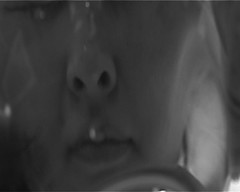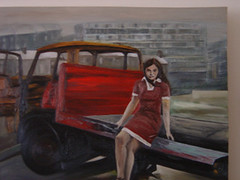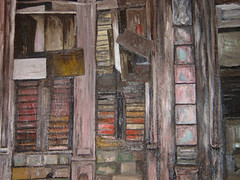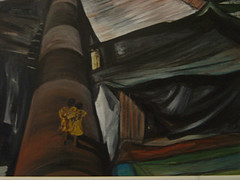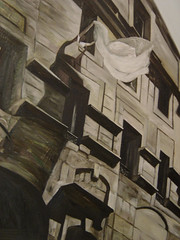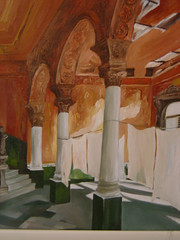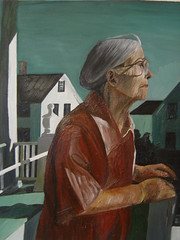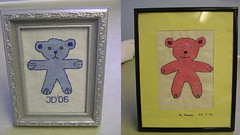video still from short film ruBbEr pLaNs
ruBbEr pLaNs, a film by alex cheung
In 2005, Context Galleries received a project award from the Promoting Interculturalism Programme of The Arts Council of Northern Ireland and Community Relations Council. Working with production company Plethora Productions, the project award was dedicated to developing and producing a new film and filmmaking skills base within the young Chinese community of the city of Derry. Rubber Plans, the film produced in the project and screened here, is the first short film by Alex Cheung, born and raised in the city, whose parents moved here from Hong Kong. The filmmaking process involved mentoring and training from Plethora Productions, Blast Furnace Recording Studios and Sound Engineer Kwame Daniels to a crew and cast from the young Chinese community of the city of Derry. Alongside the screenings here, the film Rubber Plans will be promoted to the international film festival circuit, further developing the potential of Northern Ireland’s first film from within the Chinese community.
Film screenings preview 8pm, Oct 7. Film screenings continue until Nov 4.
Film screenings preview 8pm, Oct 7. Film screenings continue until Nov 4.
Nuala Herron, Of Beauty in Ruin
Nuala Herron is a young painter from Derry, currently based in Edinburgh. The artist graduated in BA(Hons) Fine and Applied Art (Painting) at University of Ulster in 2003. Context Galleries is delighted to be bringing new work by this young artist to a first solo exhibition in her home town.
As a painter, I attempt to show beauty in what might often go unnoticed: everyday realities of the Domestic Life of a family, clothes hanging on a washing line, delapidated buildings.
In this collection of paintings I hope to show a glimpse of the frailty and transience of beauty in ruin. These ruins, delapidated and desolate scenes are a manifestation of my understanding of reality.
My paintings often evolve from photographs, some of which were taken while travelling around Europe. Rather than photographing the obvious I was more interested in delapidated buildings,walls and doors. These images were more significant to me and revealed more depth, value and beauty than their peeling surfaces suggested.
While I could appreciate the aesthetic of ruins I was also aware of a certain perversity by which we find pleasure in contemplating decay. With this in mind I have tried to create paintings 'Of Beauty in Ruin' which are honest and engaging.
Exhibition previews 8pm,Oct 7 Exhibition runs until Nov 4th
As a painter, I attempt to show beauty in what might often go unnoticed: everyday realities of the Domestic Life of a family, clothes hanging on a washing line, delapidated buildings.
In this collection of paintings I hope to show a glimpse of the frailty and transience of beauty in ruin. These ruins, delapidated and desolate scenes are a manifestation of my understanding of reality.
My paintings often evolve from photographs, some of which were taken while travelling around Europe. Rather than photographing the obvious I was more interested in delapidated buildings,walls and doors. These images were more significant to me and revealed more depth, value and beauty than their peeling surfaces suggested.
While I could appreciate the aesthetic of ruins I was also aware of a certain perversity by which we find pleasure in contemplating decay. With this in mind I have tried to create paintings 'Of Beauty in Ruin' which are honest and engaging.
Exhibition previews 8pm,Oct 7 Exhibition runs until Nov 4th
Nuala Herron, The Bogside
This painting was inspired by a photograph taken of my mother during the early part of The Troubles in 1971. It is set in Rosville Street, an area scarred by almost daily rioting, hijacking and vehicle burning. Although much of the scene is bleak and the truck has been burnt out, the prominence of the figure causes this to fade into the background. ( Painting: 3ft x 3ft, Oil on canvas)
Nuala Herron, Closed
From a photograph taken in Havana Cuba, I have attempted to capture the various textures seen on this boarded-up window: the peeling paint,the roughness of the stone,the burnt wood and flimsy cardboard.By building up several layers of paint and then scraping away some layers, I hoped to create a similar texture. (Painting: 3ftx3ft, Oil on canvas )
Nuala Herron, The Pipeline
Despite the poverty and devastation found in India, I have always been attracted to the colours and textures captured in many photographs taken. Having collected photographs for several years I had the urge to paint this particular scene, which shows a pipeline muscling snakelike through a suburb of Mumbai to supply rich areas with plenty of water. (3ftx3ft, Oil on canvas)
Nuala Herron, A Shadow Casted
In this painting, I have tried to capture a fleeting moment, something ordinary,everyday and potentially lost. The building itself is slightly decaying and the fact that it is painted prominently in shades of greys and brown enhances this. The white sheet which is being shook from the top window could signify many things, one being the continuity of life. ( painting: 3ftx3ft, Oil on canvas)
Nuala Herron, Besieged by Time
With an interest in washing lines and the feelings they connote for me, I wanted to bring this into at least one of my paintings. After discovering the photographer Robert Polidori, I came across a photograph called 'Palador La Guarida' from which I took inspiration for this painting. (3ftx3ft, Oil on canvas)
Nuala Herron, Searching
As a realist painter, I have always been drawn to painting older people and find it challenging to capture the the textures of their skin. I saw so much beauty and significance in this searching face which might be seen by many to be lost youth. I thought this was appropriate to include in my exhibition 'Of Beauty in Ruin.'
(3ftx3ft, oil on canvas)
(3ftx3ft, oil on canvas)
Nuala Herron ‘Beauty in Ruin’
In this collection of paintings the artist attempts to show a glimpse of the frailty and transience of beauty in ruin. Herron is exploring the picturesque, a time-honoured area of investigation for artists though of course putting it into a modern context. Picturesque meaning literally "in the manner of a picture; fit to be made into a picture" was a word used as early as 1703 (Oxford English Dictionary), and derived from an Italian term pittoresco, meaning, "in the manner of a painter," As meaning like beauty is transient the term ‘picturesque’ is now held in some distain and taken to mean simply pretty or charming.
In 18th Century philosophy and criticism it was however a valid stream of artistic exploration holding the middle ground between the beautiful (in the strictly traditional sense of classical i.e. Grecian aesthetic ideals) and the sublime (that appreciation of the vastness and terrible power of nature as articulated in the theories of philosophers Edmund Burke and Immanuel Kant). The picturesque borrowed from both extremes, conjoining elements of what was considered at the time ‘ideally’ beautiful (i.e. fitting the philosophical notions of beauty offered by notably the Greek philosopher and statesman Plato) with the non-rational (i.e. wild, instinctual, untamed and possibly dangerous) sublime. The notion of the picturesque was primarily articulated by the clergyman and writer William Gilpin in 1768 in a travel book designed for the English leisured classes, where he defined the picturesque as ‘that is what agreeable in a picture’. His perception of what was ‘agreeable’ however deviated from the norms of the time to include rugged landscapes and decaying buildings and even ‘decaying’ people. The artist includes portraits in her study of the potential beauty of decay and ruin. The equation of human aging with the decay of infrastructure has also a lengthy history which again leads ultimately back (in painting at least) to the theories of the Reverend Gilpin.
Unfortunately the picturesque became a fad and swarms of tourists pounced upon suitably craggy areas of England and Europe which eventually led to the devaluing of the term. Though even in the 19th Century the art critic and poet John Ruskin considered it a genuinely modern aesthetic category. Herron brings the picturesque into the contemporary context in this exhibition by including elements such as a study of an individual (her mother) in a post-riot landscape posing on a hijacked and subsequently burned vehicle and a landscape showing industrial intrusion, decay and pollution in India.
Herron’s paintings are often also studies in surface and colour which show the artist’s interest in portraying to a level which almost reaches the abstract, building facades, doors and shuttered windows. She takes the picturesque and often mixes it with painterly concerns in regard to technique and intertwines comments upon domesticity. These buildings are old and decaying but they are lived in. These areas have a massive pipeline running through it but people live and work there.
The artist often bases her painting on photographs, not always her own, thus appropriating other’s images for her own devices and reinterpreting them to give them new meaning. This can be seen in particular with her reinterpretation of a photograph by Robert Polidori of a building in Havana, Cuba in which the artist articulates her appreciation of decay and beauty and gives prominence to the obvious domestic associations of the building by highlighting the white sheets on the washing line.
(Text by Gregory McCartney)
This the artist’s first solo show in the Context though she did appear in the ‘Take Away’ group show in 2004.
The exhibition runs 7th October – 4th November 2006
In 18th Century philosophy and criticism it was however a valid stream of artistic exploration holding the middle ground between the beautiful (in the strictly traditional sense of classical i.e. Grecian aesthetic ideals) and the sublime (that appreciation of the vastness and terrible power of nature as articulated in the theories of philosophers Edmund Burke and Immanuel Kant). The picturesque borrowed from both extremes, conjoining elements of what was considered at the time ‘ideally’ beautiful (i.e. fitting the philosophical notions of beauty offered by notably the Greek philosopher and statesman Plato) with the non-rational (i.e. wild, instinctual, untamed and possibly dangerous) sublime. The notion of the picturesque was primarily articulated by the clergyman and writer William Gilpin in 1768 in a travel book designed for the English leisured classes, where he defined the picturesque as ‘that is what agreeable in a picture’. His perception of what was ‘agreeable’ however deviated from the norms of the time to include rugged landscapes and decaying buildings and even ‘decaying’ people. The artist includes portraits in her study of the potential beauty of decay and ruin. The equation of human aging with the decay of infrastructure has also a lengthy history which again leads ultimately back (in painting at least) to the theories of the Reverend Gilpin.
Unfortunately the picturesque became a fad and swarms of tourists pounced upon suitably craggy areas of England and Europe which eventually led to the devaluing of the term. Though even in the 19th Century the art critic and poet John Ruskin considered it a genuinely modern aesthetic category. Herron brings the picturesque into the contemporary context in this exhibition by including elements such as a study of an individual (her mother) in a post-riot landscape posing on a hijacked and subsequently burned vehicle and a landscape showing industrial intrusion, decay and pollution in India.
Herron’s paintings are often also studies in surface and colour which show the artist’s interest in portraying to a level which almost reaches the abstract, building facades, doors and shuttered windows. She takes the picturesque and often mixes it with painterly concerns in regard to technique and intertwines comments upon domesticity. These buildings are old and decaying but they are lived in. These areas have a massive pipeline running through it but people live and work there.
The artist often bases her painting on photographs, not always her own, thus appropriating other’s images for her own devices and reinterpreting them to give them new meaning. This can be seen in particular with her reinterpretation of a photograph by Robert Polidori of a building in Havana, Cuba in which the artist articulates her appreciation of decay and beauty and gives prominence to the obvious domestic associations of the building by highlighting the white sheets on the washing line.
(Text by Gregory McCartney)
This the artist’s first solo show in the Context though she did appear in the ‘Take Away’ group show in 2004.
The exhibition runs 7th October – 4th November 2006
Subscribe to:
Posts (Atom)
